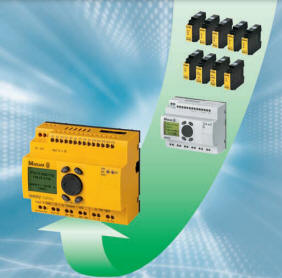Eaton/Moeller
EASY Safety Relay Overview |

Packed with a host of conventional safety relays in the form
of safety function blocks,
easySafety not only features integrated safety functions but
also standard functions
in a single device – all in one.
In addition to the safety circuit diagram containing the
safety configuration, the
safety control relay also contains a standard circuit
diagram. This circuit diagram can
be used for standard texts, such as the processing of
diagnostics signals or general
control tasks of a machine.
Thanks to the large number of safety function blocks, this
provides the user with
many application options within one device. The user can
also respond directly to
future and changing application requirements. This saves
financial resources and
offers future investment security.
easySafety meets the requirements of category 4 to EN 954-1,
PL e to EN ISO 13849-1,
SILCL 3 to EN IEC 62061 and SIL 3 to EN IEC 61508. With
easySafety, it is therefore
possible to implement applications meeting the most
stringent safety requirements. |
| |
 |
Emergency-Stop circuits
Allows the safe stopping of a
dangerous movement, immediate stop Stop category 0
and controlled stop Stop category 1 according to EN
60204-1; field of application - safety orientated
one or two channel monitoring of
emergency stop circuits. |
|
 |
Contactless protective devices
(ESPE)
Protection of the hazardous
location or area in the vicinity of
machines by means of contact less guards such as
light grids/light barriers/light curtains. |
|
 |
Optionally with muting
function
that temporarily bypasses the
protective function of a guard such as a light grid.
Typical application for the material feed of a
machine without interrupting the working process. |
|
 |
Operating mode selector
switch
Used for the safe selection and
acceptance of a pre-selected
operating mode on an external
control device. |
|

 |
Enable switch
The manual or foot operated enable switch allows the
temporary enabling of a guard, such as a safety
door, by continuous actuation. This may be necessary
for setting or servicing a
machine. |
|
 |
Guard door monitoring with
and without monitoring of
interlock/guard locking
Used with moving guards such as doors, barriers or
flaps. Positions are reliably detected, monitored
and enabled to safety-related requirements –
optional interlock device with guard locking when
increased personal and process protection are
required; this securely keeps the guard closed until
machine standstill. |
 |
|
 |
Feedback circuit monitoring
(EDM)
Used for the safety-related
monitoring of externally connected
actuators, e.g. contactors, relays or valves. |
|
 |
Safety timing relay
Used for changing the switch
duration and the on or off switch
points of an enable contact in the
safety circuit. Safety-related timing relay with on
and/or off delayed or single pulse function. |
|
 |
Stand still monitoring
Used when the entry or access to the hazardous area
is not permitted until the hazardous driving force
has come to a
standstill. |
|
 |
Safe operation with two-hand
control
Type III to EN 574. Used for
hazardous machine movement
such as presses, punching,
shearing. It allows the movement
of dangerous operation only when
both hands of the operator are
outside the dangerous area and
the two pushbuttons are operated
within 0.5 seconds of each other. |
|
 |
Monitoring of open hazardous
areas with safety mats
Used for the safety-related
monitoring of cross-circuits formed by safety mats. |
|
 |
Start element
For the safe starting of an
application by means of an
external start button or start
condition from the safety circuit
diagram. |
|
 |
Maximum speed monitoring
For the safety-related over speed
monitoring of a motor or a shaft. If
the maximum speed is exceeded, the drive is
disabled. |
|
|
| |